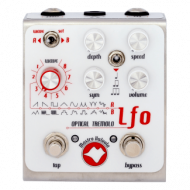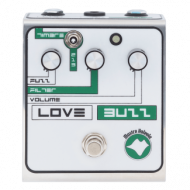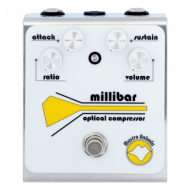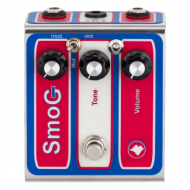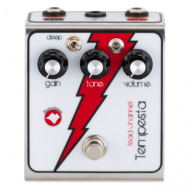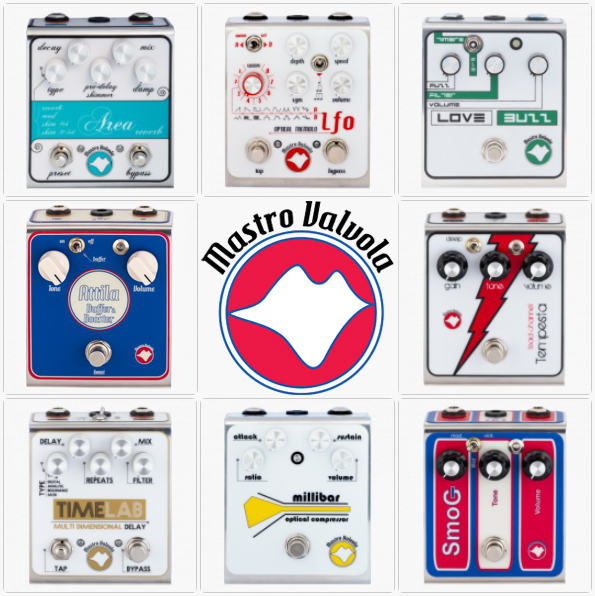
A country filled with art and passion, Italy is known for producing many high-end goods, and Mastro Valvola (which translates to Valve Master) has taken the mentality of crafting premium products into the hand-made guitar pedal niche. The company was established in 2008 by founder and amplifier guru Luca Romanelli and a small team of tone fanatic engineers with a passion for making versatile, high-quality stompboxes.
Mastro Valvola’s entire product range is handcrafted at their shop in Italy, from concept to creation to completion. All stages of the manufacturing process are done in-house, including the graphics. Their first offering to hit the market was the Smog transparent overdrive, and their growing product line now includes gain, modulation, and time-based effects.
Luca understands that every element of a rig contributes to quality tone, and many of their products feature an all-analog design or a hybrid of analog and digital technologies that serve up tone featuring the best of both worlds.
The company’s pedals are designed to offer the most tonal variety in packages that are as streamlined as possible, and most of them work equally well on guitar or bass (or keyboards!). These are truly meant to be conduits for inspiration, each with their own defined and original character, not just another pedal in the chain. A selection of them can also be run at 12v, increasing headroom and allowing them to integrate with any rig design.
With their versatile, quality circuits built into enclosures with retro, eye-catching aesthetics, this up-and-coming manufacturer’s stompboxes are worth a test drive.
Here’s our interactive gallery with a selection of the company’s most popular products (click for videos!):
We asked owner Luca a few questions about his shop:
How did you become interested in making pedals?
One day I went to a string instrument workshop in Florence where I used to repair instruments, and I brought with me the prototype of what has then become the Smog overdrive. The excitement that came from the successful results that day is what spurred me on to create the brand “Mastro Valvola”, which is still working on with great passion.
How important is it to incorporate analog elements into your designs in an industry that is becoming increasingly digital?
I’m not an anolog purist. As a pedal designer I think the choice between analog and digital is tied to the goal I want to achieve. Each of these formats excels at specific tasks and for me it actually feels very satisfying to get them to work together within the same product. In this regard, in our latest pedal, the LFO Optical Tremolo, I used the analog opto-isolator technology to achieve the character and warmth of the old analog tremolo circuits of the ’60s, adopting digital to allow a wide range of options to fine-tune the settings, something that I wouldn’t have been able to do with just analog.
Which is your favorite pedal of all of your designs?
The Millibar Optical Compression, maybe because of the circumstances that have lead to its creation.
I came up with the idea for the “Millibar” when a well-known Italian guitarist and arranger challenged me to create a compressor pedal that would sound like the legendary 1176 or LA2A studio compressors. Those units don’t distort the attack and have a natural and transparent compression that doesn’t alter the timbre of the instrument, while letting the harmonics ring out. “Practically, a compressor that even those who don’t like compressors will like”, he told me.
It was challenge at once intriguing and frightening. The design and development stage was very long and complex, it took about two years. In the end, I managed to overcome the challenge by involving this guitarist and his sound tech in the development. The Millibar is now one of our most successful pedals.
What makes you decide which features will be included in your pedals?
For me it’s really crucial to grant the design a character that makes it stand out from other similar effects. I always try to focus on features that will make it unique within its niche.
What kind of new products can we look for in the future?
We have a series of prototypes we are working on, I don’t know yet which one will see the light of the day, but I can say that one of the projects closer to being finalized is a Vibrato/Chorus, somewhat inspired by the LFO’s design and functionality but with extra controls for expression pedal and CV, therefore opening the door of modular synth compatibility.
How do you know when a design is “finished” and ready for the market?
Many factors go into this, but first and foremost a pedal is ready when I am entirely satisfied with it. I need to be 100% excited about its sound, design quality, graphics, innovation, interface etc.
Something that also needs to be considered is the availability of all the components and the finalization of the production logistics, which need to be carefully planned and verified before the launch of a product.
















